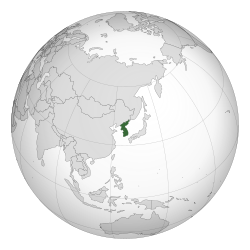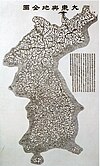
Back حكومة جمهورية كوريا المؤقتة Arabic Gobiernu provisional de la República de Corea AST Koreya Respublikası Müvəqqəti Hökuməti Azerbaijani Govern provisional de la República de Corea Catalan Koreas eksilregering Danish Provisorische Regierung der Republik Korea German Προσωρινή Κυβέρνηση της Κορέας Greek Gobierno provisional de la República de Corea Spanish دولت در تبعید کره Persian Gouvernement provisoire de la république de Corée French
Provisional Government of the Republic of Korea 대한민국 임시정부 大韓民國臨時政府 | |||||||||
|---|---|---|---|---|---|---|---|---|---|
| 1919–1945[1] | |||||||||
| Motto: 대한독립만세 (Hangul) 大韓獨立萬歲 (Hancha) "Long Live Korean Independence" | |||||||||
| Anthem: 애국가 Aegukga "The Patriotic Song" | |||||||||
Government Seal | |||||||||
 | |||||||||
| Status | Unrecognized, provisional government in exile | ||||||||
| Capital-in-exile | Shanghai (1919–1932) Hangzhou (1932–1935) Jiaxing (1935) Nanjing (1935–1937) Changsha (1937–1938) Guangzhou (1938–1939) Qijiang (1939–1940) Chongqing (1940–1945) | ||||||||
| Official languages | Korean | ||||||||
| Government | Presidential republic (1919–1925) Parliamentary republic (1925–1940) Semi-presidential republic (1940–1945) | ||||||||
| President | |||||||||
• 1919–1925 (first) | Syngman Rhee[a] | ||||||||
• 1940–1945 (last) | Kim Ku | ||||||||
| Prime Minister | |||||||||
• 1919–1921 (first) | Yi Dong-nyeong | ||||||||
• 1924–1925 (last) | Park Eun-sik | ||||||||
| Legislature | Provisional Parliament | ||||||||
| History | |||||||||
| 1 March 1919 | |||||||||
| 11 April 1919 | |||||||||
• Unified with Korean Vladivostok and Seoul governments | 11 September 1919 | ||||||||
• War declared against Axis | 9 December 1941 | ||||||||
| 27 November 1943 | |||||||||
| 15 August 1945 | |||||||||
| 8 September 1945 | |||||||||
| Currency | Korean won | ||||||||
| |||||||||
| Today part of | China South Korea North Korea | ||||||||
| Provisional Government of the Republic of Korea | |
| Hangul | 대한민국 임시정부 |
|---|---|
| Hanja | 大韓民國臨時政府 |
| Revised Romanization | Daehanminguk Imsijeongbu |
| McCune–Reischauer | Taehanmin'guk Imsijŏngbu |
| History of Korea |
|---|
 |
| Timeline |
|
|
| History of South Korea |
|---|
 |
|
|
The Korean Provisional Government (KPG), formally the Provisional Government of the Republic of Korea (Korean: 대한민국 임시정부), was a Korean government in exile based in China during the Korea under Japanese rule.
The KPG was founded in Shanghai on 11 April 1919. A provisional constitution providing for a democratic republic named the "Republic of Korea" was enacted. It introduced a presidential system and three branches (legislative, administrative and judicial) of government. The KPG inherited the territory of the former Korean Empire. The Korean resistance movement actively supported the independence movement under the provisional government, and received economic and military support from the Kuomintang, the Soviet Union, and France.[2][unreliable source?][3][4][5][6] After 1932, the KPG moved to a number of different cities and eventually settled in Chongqing until the end of World War II in 1945. Several of the buildings used as the headquarters of the KPG in Shanghai and Chongqing are now preserved as museums.[7]
After the surrender of Japan on 15 August 1945, the provisional government came to an end.[1][8] Its members returned to Korea, where they put together their own political organizations under the American military administration and competed for power in what would become South Korea.[1] On 15 August 1948, Syngman Rhee, who had been the first president of the Provisional Government, became the first President of the Republic of Korea.
The current South Korean government claims through the 1987-amended constitution of South Korea that there is continuity between the KPG and the current South Korean state, though this has been disputed by scholars and historians.
- ^ a b c "Korean-Provisional-Government". Encyclopedia Britannica. 8 August 2023.
- ^ 임시정부 항주기념관에 김구 사진이 빠진 이유[대한민국임시정부 100년, '임정로드'를 떠나다] 일곱 번째 이야기, 항주 유적지에 가다. 22 August 2019.
- ^ "[3ㆍ1운동.임정 百주년](38) 장제스의 임정 지원, '선의'뿐일까?". 4 March 2019.
- ^ [의열단100주년]⑬불꽃같은 삶 김산…비운의 '아리랑'. 20 October 2019.
- ^ "SDC인터내셔널스쿨, 3.1운동 및 대한민국 임시정부수립 100주년 기념 나라사랑 콘서트 개최". 12 August 2019.
- ^ 프랑스서 독립운동 홍재하 선생 후손 등 방한. 11 August 2019.
- ^ Kim, seon-yeong (15 August 2021). 한∙중 우호의 상징이 된 대한민국 임시정부 청사 [Provisional Government Building, Becomes a Symbol of Friendship between Korea and China]. 퍼블릭뉴스 (in Korean). Retrieved 15 April 2023.
- ^ "Provisional Government of the Republic of Korea". National Library of Korea. 8 August 2023.
Cite error: There are <ref group=lower-alpha> tags or {{efn}} templates on this page, but the references will not show without a {{reflist|group=lower-alpha}} template or {{notelist}} template (see the help page).

